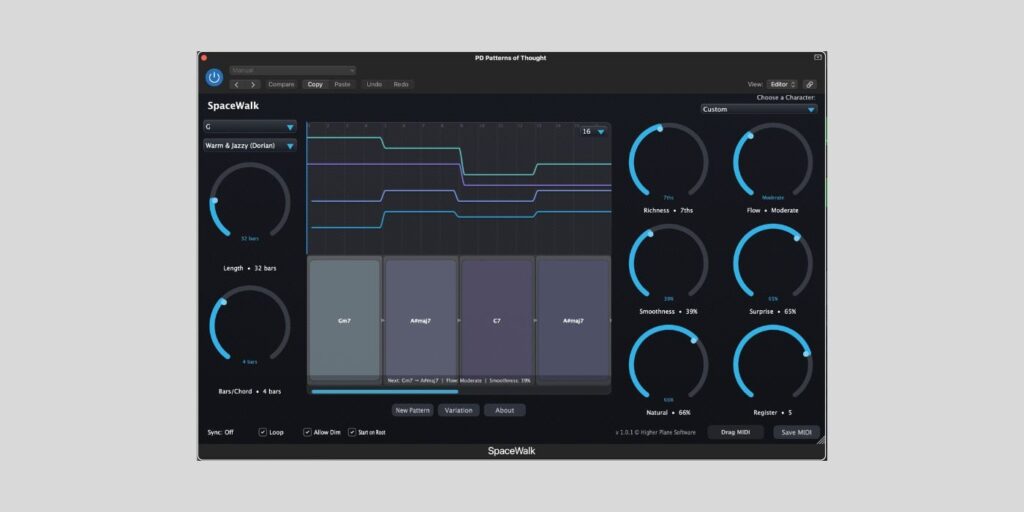Developer Higher Plane has released SpaceWalk, a free ambient chord progression generator for macOS and Windows.
Chord progression generators often divide opinion, and the debate generally creates two camps: those who think you must fill every bar with complexity to ensure your music is as esoteric as possible, and those who consider music theory to be a waste of time and effort.
Neither musical snobbery nor closing technical doors is beneficial for any musician, yet we still miss so much common ground in between.
I studied music theory; I geek out on it, but some of my favorite musicians barely play four chords, and I can’t do what they do. The golden rule of music is that if it sounds good, it’s correct; that’s it.
So, as someone who hates the thought of AI taking creativity out of human hands, I welcome tools that can help and educate us simultaneously, and that’s what we have with SpaceWalk (unity-encouraging rant over).
Higher Plane designed SpaceWalk to help ambient musicians lay down solid foundations for a track quickly, which provides the momentum that creativity needs, and allows them to focus on other elements.
SpaceWalk functions by adding it as a MIDI effect before your synth VST (the developer recommends Vital, Serum, and Pigments – all good calls).
If you’re looking for a new synth sound, DAWJunkie’s Slurpy Jr. is free for a limited time.
SpaceWalk is compatible with most popular DAWs (no issues here with Logic Pro), but Reason users should check the notes on the product page.
Available in AU, VST3, and Standalone formats for macOS (11.0 and higher) and Windows (10 and higher).
To get started, you can select a key and scale/mode quality for your progression. When selecting a scale/mode quality, the menu provides helpful generalized character descriptions like:
- Major – Bright & Uplifting
- Dorian – Warm & Jazzy
- Whole Tone – Floating & Weightless
It’s good to see the whole tone scale included; it’s perfect for more than entering dream sequences in cheesy sitcoms! You even have a chromatic option, if you want to think more atonally.
Beyond the key signature, you can also set a defining character, including Deep Lydian Cloud, Pure Triads, and Melancholic Journey.
To generate a pattern, click the New Pattern button, and to create a variation of the current pattern, click the Variation button.
You further shape your progression using the various parameter controls, with more to come in version 1.1 (I’ll touch on that at the end).

The more creative parameters are Richness, Flow, Smoothness, Surprise, and Natural.
The Richness control introduces further chord extensions, including 9ths and beyond. I appreciate the inclusion of further extensions; it’s not just about music theory. If used at the right time, they can introduce new textures or tension.
Increasing the Flow creates smoother transitions between chords (go the other way for more obvious jumps), and SpaceWalk has a nice morphing quality already that’s ideal for the evolving soundscape approach.
The Smoothness control expands on the transition style with a smooth legato or spikier feel.
The Surprise control is one of my favorites; it introduces subtle modal shifts in the progression, and even a half/whole step shift from the expected target keeps a sequence alive.
The Natural parameter is also important because it humanizes the progression by adjusting the timing and dynamics.
One of the things I like most about SpaceWalk is that it’s sensible about chord voicings. It’s not complex voice leading for inner/outer movements, but it’s smart, and what you want for ambient cinematic music. You often end up with lovely ascending/descending top notes or beautiful pedal notes that ring throughout several bars.
Nick Tsiatinis, the developer behind SpaceWalk, says he’s not a musician; you don’t have to be a virtuoso to be a musician, but if he means he doesn’t come from a traditional musical background, he’s done a great job of creating a tool that bridges the gap, rather than widening it.
If I had one small issue, with my theory hat on, progressions show sharps where there should be flats. For example, in the key of G minor, you can have a progression like: Gm7-A#maj7-Am7-Gm7 rather than Gm7-Bbmaj7-Am7-Gm7.
Tonally, it’s the same thing, and it sounds beautiful. The reason I mention it comes from an educational viewpoint.
Diatonically (and generally), we wouldn’t have A and A# in the same sequence. The reason is that when we are in the key of G minor, using purely diatonic chords, and we see an A chord, we know it’s minor (or at least has an A natural root), and Bb rather than A# is much clearer; key signatures, tedious as they are, are theory hacks to remember diatonic chord qualities.
Another reason I mention it is that SpaceWalk can be educational; if we learn/remember progressions/changes that we like, rather than just using them, then play them on piano or guitar in the future, it’s a win-win.
Lastly, for anyone who stuck around this long, I mentioned some exciting updates coming soon. Version 1.1 will allow us to alter voicings, spread voicings, utilize sus2/4 voicings, lock chords in place, and more.
Check it out, and while SpaceWalk is available for free, donations are welcome if you’d like to support current and future work.
Download: SpaceWalk (FREE / Name-a-fair-price)
Deal of the day 🔥: Get 70% OFF any SoundMorph product (starting at $14!)!
More:
Last Updated on October 15, 2025 by Tomislav Zlatic.




